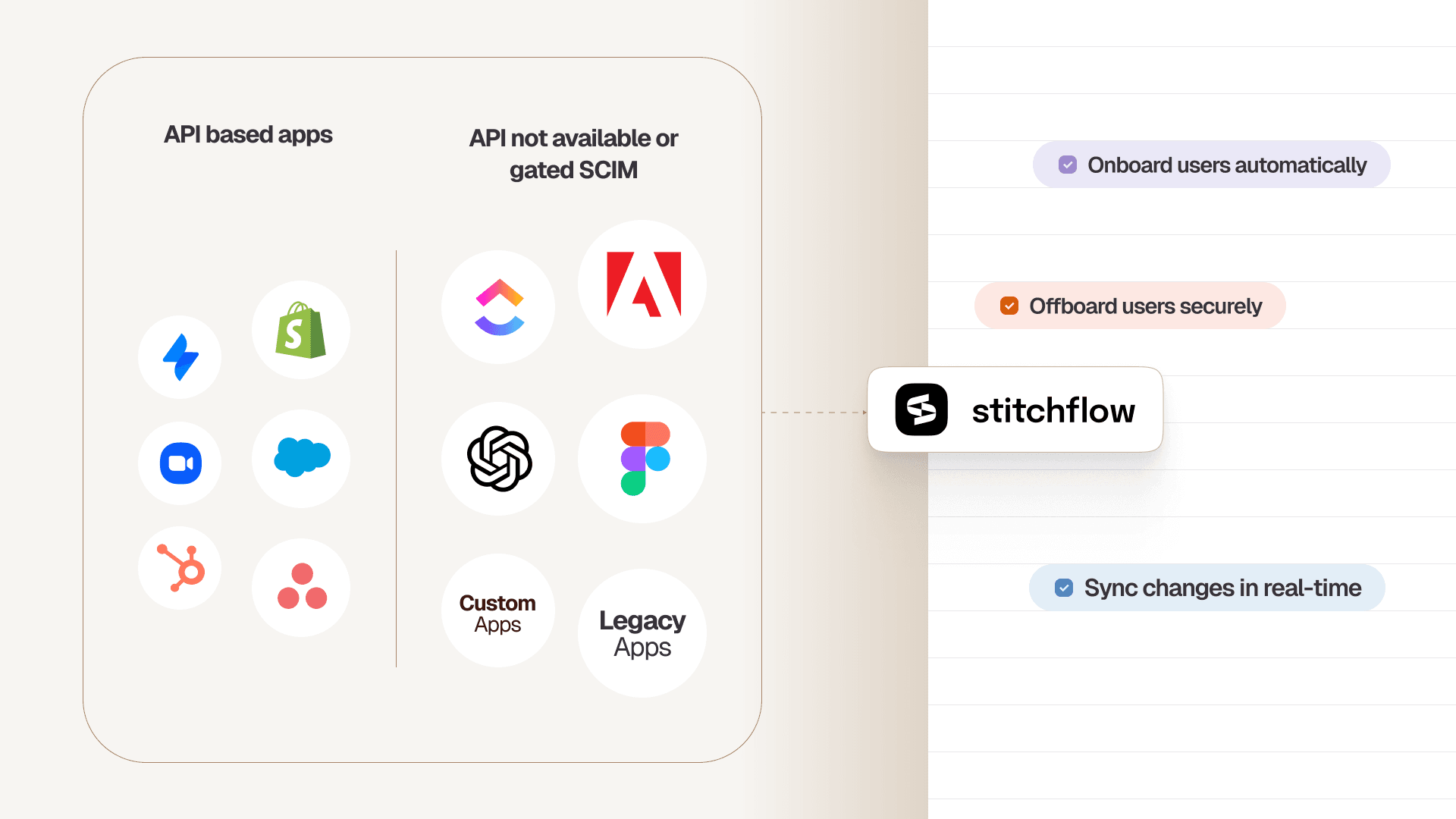You're the head of IT, and your Slack pings are at 10 pm. Legal lost access to a contract review tool right before a major deadline. The license expired weeks ago. No one renewed it. Worse? You didn't even know the tool existed.
This is what license management looks like in companies grappling with business sprawl, where tool chaos and fragmented systems create license waste and risk.
Business sprawl happens when a company's IT environment grows without a clear structure: multiple identity providers, inconsistent access policies (with varying rules across departments, roles, locations, and employee types), fragmented domains, and edge-case exceptions pile up quickly.
The result? Wasted spending, security risks, and operational headaches.
To rein in such chaos, companies need a deliberate, structured approach to software license management. This guide outlines the best practices for software license management in complex, fast-moving environments—so you can stay compliant, save money, and keep IT sane.
TL;DR
- Software license management ensures the right tools are in the right hands and with proper permissions, so you avoid overspending or compliance-related issues.
- Common challenges with software license management include unused licenses, compliance risks, decentralized purchasing, missed renewals, and security vulnerabilities.
- You can optimize software licenses by centralizing tracking, automating renewals, enforcing role-based access control, and aligning license counts with your business priorities.
- Modern SaaS license management, like Stitchflow, uses managed browser automation to provide 100% coverage, finding unused licenses in disconnected apps (like Adobe) that other tools miss and letting you fix gaps in bulk or via an ITSM ticket.
What is software license management?
Software license management is the practice of monitoring, controlling, and optimizing the acquisition, deployment, use, and renewal of software licenses. Its purpose is to ensure that an organization uses software legally and efficiently, while minimizing costs and reducing compliance risks.
When it's working well, SaaS license management enables you to:
- Avoid penalties from unexpected vendor audits
- Stop throwing money at licenses that no one's using
- Keep your systems secure by controlling who has access to what
- Ensure teams always have the tools they need to get work done
However, traditional software licenses management practices assume a stable, centralized IT environment, which is not the reality for most fast-growing companies today.
With departments adopting tools, contractors, and remote workers coming and going, a single source of truth for software access is lacking, and license management often falls apart.
Key challenges in software license management
Managing software licenses comes with a host of challenges that can quickly impact costs, security, and operations. From unused licenses and compliance risks to decentralized purchasing and missed renewals, here are some challenges you might have to deal with:
1. Unused and redundant licenses
Many organizations keep paying for tools assigned to former employees or inactive accounts simply because offboarding and visibility are incomplete, especially for the 20-40% of apps without SCIM or APIs. When this happens across dozens of apps, wasted spend quickly adds up.
‼️During one of our conversations with a customer, they mentioned 100+ licenses were assigned to suspended users because their offboarding workflows didn’t account for group-based access.
The root issue? A lack of visibility. New tools are deployed and users are onboarded, but offboarding and usage tracking are inconsistent, leaving licenses idle and unmanaged until it’s too late.
2. Compliance risks
Without clear oversight, organizations can easily breach software license terms—particularly with per-user or tiered agreements. Licenses may be assigned to inactive users, mismatched across tiers, or left active longer than allowed—creating audit exposure and potential legal or financial consequences.
3. Decentralized purchasing
When individual teams buy software without coordination, organizations often end up with duplicate tools and miss out on volume discounts. This, in turn, drives up costs, complicates management, and makes it harder to maintain compliance across the company.
4. Missed renewals
If you don’t track who owns each tool or when licenses expire, renewals can slip through the cracks. That means you might suddenly lose access to critical apps, scramble to renew at the last minute, or pay inflated fees—disrupting your team’s workflow and budget.
⛔One company even lost access to critical infrastructure because a developer used their personal account to sign up for Microsoft Azure, and no one knew about this when they left.
5. Security vulnerabilities
Outdated, unmanaged, or orphaned software is a backdoor waiting to be exploited. How can you secure a tool if IT doesn't even know it exists?
Addressing these challenges requires a structured approach to software license management, leveraging automation and best practices to maintain control over software assets.
🧠Did you know inactive user accounts are one of the most common drivers of license waste? Learn why they happen, their risks, and how to fix them before they become security liabilities.
Unlock SCIM for any app without the enterprise upgrade
Trigger automated provisioning in your IdP just like native SCIM. Enabled by resilient browser automation, backed by 24/7 human monitoring, at a fraction of the enterprise plan cost.

10 best practices for software license management in complex environments
Here are some enterprise software license management best practices to help you optimize spend, maintain compliance, and keep your budget under control.
1. Centralize software license tracking
Create a unified inventory of all software licenses across departments, roles, and employee types. Ideally, this is automated and continuously updated (more on that later). You can't optimize what you can't see.
"If you can't see all your licenses, you can't secure them, you can't optimize them—and you definitely can't manage them."
🎯Pro tip: Include internal tools and open-source systems in your catalog. Even if they don’t require paid licenses, tracking them helps you maintain visibility, security, and compliance.
2. Eliminate unused and redundant licenses
Regularly auditing software usage helps organizations identify and eliminate redundant licenses. By consolidating tools with overlapping functionalities, businesses can reduce costs and simplify license management.
Platforms like Stitchflow make this easier by automatically identifying underused licenses across your entire stack—even those without SSO/SCIM—and letting you reclaim them with just a few clicks.
💡License utilization vs. entitlements
It’s important to differentiate between what licenses are entitled (assigned) and what is actually utilized. Tracking only entitlements can hide wasted spend, while monitoring true usage gives you actionable insights to optimize your license portfolio.
📚Also read: How to Manage External Users in Modern IT Environments
3. Automate license renewals and monitoring
Manual tracking is a recipe for missed renewals. Use tooling to set automated alerts for renewal dates—ideally with enough runway to renegotiate contracts or consolidate vendors when needed.
Another point to keep in mind: disconnected apps—and shadow IT—can easily slip through the cracks, leading to unexpected expirations, last-minute purchases, or wasted spend. We recommend using a SaaS management platform that covers the gap left by your IDP to keep track of these apps.
For example, Stitchflow provides 100% coverage by using managed browser automation to find and manage licenses even in disconnected apps that IDPs can't see, like those that lock SCIM behind expensive enterprise plans.

👉 Want to uncover gaps in your SaaS management automation? Take this free 5-minute quiz to identify offboarding issues, SCIM gaps, and SaaS access blind spots your IDP might be missing.
4. Establish clear procurement policies
A structured software procurement policy prevents different teams from purchasing duplicate or unneeded tools. Centralized purchasing ensures cost efficiency and compliance with company-wide standards. This can help you:
- Avoid SaaS sprawl: Prevent purchasing tools that overlap with existing licenses.
- Control costs: Gain leverage for bulk purchases, negotiate better deals, and stick to budgets.
- Standardize for compliance: Make sure every software acquisition meets organizational requirements and follows a consistent process.
5. Use role-based access control (RBAC) to avoid over-provisioning
Assigning software licenses based on user roles ensures that employees can access the tools they need without over-provisioning. RBAC prevents over-provisioning, reduces security risks from unnecessary access, and cuts unnecessary license costs.
It also simplifies audits and license management by clearly mapping which roles require which tools, making it easier to onboard new users or offboard departing employees without leaving orphaned licenses behind.
If you want to set up an access control matrix to track apps and license usage, then we suggest trying Stitchflow’s free Access Control Matrix.
It provides unified visibility across all apps and users, lets you filter by assigned or missing access, and helps IT admins quickly spot gaps, revoke unnecessary permissions, and standardize access. You can also download the matrix as a CSV to share with your team.
6. Regularly review vendor agreements
Software vendors often update licensing terms, typically in response to rising operational costs, changes in usage patterns, or new feature releases. These updates can introduce unexpected fees, stricter usage limits, or altered access policies.
⛔ Take Cursor’s Pro plan, for example—users were caught off guard by new limits and automatic charges, sparking confusion and refunds.
By reviewing agreements regularly, you can stay on top of changes, understand new cost structures, and renegotiate terms if needed—preventing surprises and ensuring your team can rely on the tools they need without disruption.
7. Integrate license management with IT service management
Software license management (SLM) is most effective when integrated with ITSM processes. While SLM ensures licenses are purchased, assigned, and tracked efficiently, ITSM provides the workflows and ticketing structure to manage software requests, license reassignments, and compliance. This can help you in two ways:
- Automatic license reclamation workflows: Once a license is available, you can create ITSM tickets to reassign them to a new user or device via automated approval workflows
- Device-led license tracking: You can create a centralized repository that maps each physical device to the software installed on it, giving full visibility into software allocation optimization opportunities
💡For example, you can connect your SaaS management platform—like Stitchflow—with a service desk like Jira and set up license reclamation workflows. Once a user leaves, Stitchflow can automatically generate a ticket in Jira to reclaim the license.
8. Ensure compliance through continuous monitoring
Regularly tracking license usage helps you catch discrepancies before they become compliance issues. Without it, audits can expose untracked software, outdated entitlements, or shadow IT. Continuous monitoring keeps your records accurate, adapts to changing vendor terms, and ensures you only pay for what your team actually uses.
‼️For example, Gulf Coast Pain Consultants faced a $1.19 million fine after a former contractor accessed their EMR system three times after termination, using patient data to submit fraudulent Medicare claims.
9. Use modern software license management tools
Manual spreadsheets can’t track thousands of users, multiple apps, and dynamic cloud environments. Modern tools for software license management (like Stitchflow), on the other hand, provide:
- Real-time license utilization tracking: See which licenses are actively used versus assigned, so you can reclaim idle ones.
- Automated renewals and alerts: Get notifications before contracts expire and identify opportunities to consolidate vendors.
- Role and access-based management: Map software access to user roles to prevent over-provisioning and reduce security risk.
This means you get full visibility, reduce wasted spend, maintain compliance, and simplify the software license management process across even the most complex environments.
📚Also read: A Step-by-Step Guide to Software License Optimization for Modern IT Teams
10. Align license management with business needs
As companies grow and evolve, so do their software requirements. By regularly reviewing licenses and analyzing app usage trends, you can identify underused tools, reassign or retire licenses, and plan for future growth.
This ensures every software dollar directly supports business priorities, prevents waste, and gives leadership confidence that the organization’s software stack scales efficiently without overspending.
Optimize SaaS license management with Stitchflow
For companies navigating complex IT environments, the real problem isn't just seeing licenses; it's the lack of automation that creates waste and risk in the first place.
Your IDP (like Okta or Entra) is great for 60-70% of your apps, but it leaves a 20-40% "automation gap". This gap is full of "disconnected apps"—tools without APIs or, more commonly, apps that lock critical SCIM provisioning behind expensive enterprise plans.
This "SCIM tax" forces you to choose between paying thousands more per user or sinking 2+ days a week into risky, manual provisioning and deprovisioning.
Stitchflow closes this gap. We provide SCIM capabilities for 100% of your apps, even if they don't have SCIM.
We do this through managed browser automation—a headless browser in a secure VPN that performs any admin action a human would.
Unlike brittle RPA scripts that you have to build and maintain, Stitchflow guarantees 99.5% uptime. Every automation is backed by a 24/7 human-in-the-loop (HITL) reliability team that monitors every run and instantly handles any failures, UI changes, or re-authentications.
With Stitchflow, you can:
- Automate 100% of User Lifecycle Workflows: Automatically provision, deprovision, and manage access for any app (like Figma, Adobe, Atlassian, and Netsuite) directly from your existing IDP or workflow tool.
- Stop Paying the "SCIM Tax": Get the full automation of an enterprise plan at a fraction of the cost. For most apps, Stitchflow pays for itself with fewer than 10 users.
- Eliminate Security & Compliance Gaps: Ensure ex-employees are deprovisioned from every app, every time, with a full, auditable video-recorded trail.
Stitchflow customers typically reclaim over 20% in software spend through smarter license management. Turing, for example, found 150+ idle licenses—reclaiming $60K in annual SaaS savings.
Book a demo to close your automation gap and eliminate the SCIM tax.
Frequently asked questions
As you scale, license waste usually comes from three places: ex-employees not being fully offboarded, contractors and vendors left active past their term, and premium licenses assigned by default instead of based on actual usage.
To stay ahead, reconcile licenses with your IDP and HR systems at least quarterly, set license expiry dates for contractors, and reclaim or downgrade seats based on actual feature adoption, not just logins.
Jane is a writer at Stitchflow, creating clear and engaging content on IT visibility. With a background in technical writing and product marketing, she combines industry insights with impactful storytelling. Outside of work, she enjoys discovering new cafes, painting, and gaming.


